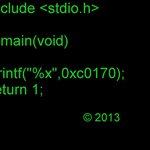This is a very simple guide, reviewing the steps required to get Blinky working on an Mbed OS platform.
Mbed OS Blinky
This example shows the use of a DigitalOut object to represent an LED and use of the nonblocking Thread::wait() call. Using nonblocking calls is good practice because Mbed OS can schedule and run other threads while the first thread is waiting.
Building this example
Building with Arm Mbed CLI
To use Mbed CLI to build this example, follow the instructions in the documentation. The instructions here relate to using the Arm Online Compiler.
To use the Online Compiler, import this code into the Online Compiler, and select your platform from the top right. Compile the code using the compile button, load it onto your board and press the reset button on the board. The code will run on the board, and you will see the LED blink.
You can find more instructions for using the Mbed Online Compiler in the documentation.
Revision 100:ec006d6f3cb6, committed 2019-10-14
- Comitter:
- mbed_official
- Date:
- Mon Oct 14 14:00:04 2019 +0100
- Parent:
- 99:394543729870
- Child:
- 101:130fd2e532f0
- Commit message:
- Call `thread_sleep_for` to sleep (#193)
This function allows the application to be built wit the bare metal
profile without requiring `rtos-api` to be added in the list of required libraries.
.
Commit copied from https://github.com/ARMmbed/mbed-os-example-blinky
Changed in this revision
| main.cpp | Show annotated file Show diff for this revision Revisions of this file |
--- a/main.cpp Tue Oct 01 11:00:04 2019 +0100
+++ b/main.cpp Mon Oct 14 14:00:04 2019 +0100
@@ -4,7 +4,7 @@
*/
#include "mbed.h"
-#include "ThisThread.h"
+#include "platform/mbed_thread.h"
#include "stats_report.h"
DigitalOut led1(LED1);
@@ -21,7 +21,7 @@
while (true) {
// Blink LED and wait 0.5 seconds
led1 = !led1;
- ThisThread::sleep_for(SLEEP_TIME);
+ thread_sleep_for(SLEEP_TIME);
if ((0 == count) || (PRINT_AFTER_N_LOOPS == count)) {
// Following the main thread wait, report on the current system status
 mbed-os-examples
mbed-os-examples


 L-Tek FF1705
L-Tek FF1705